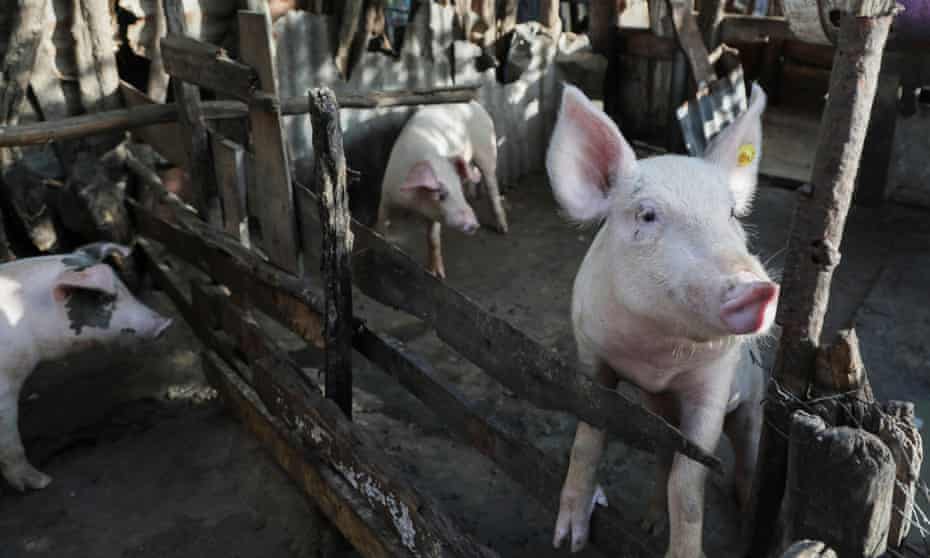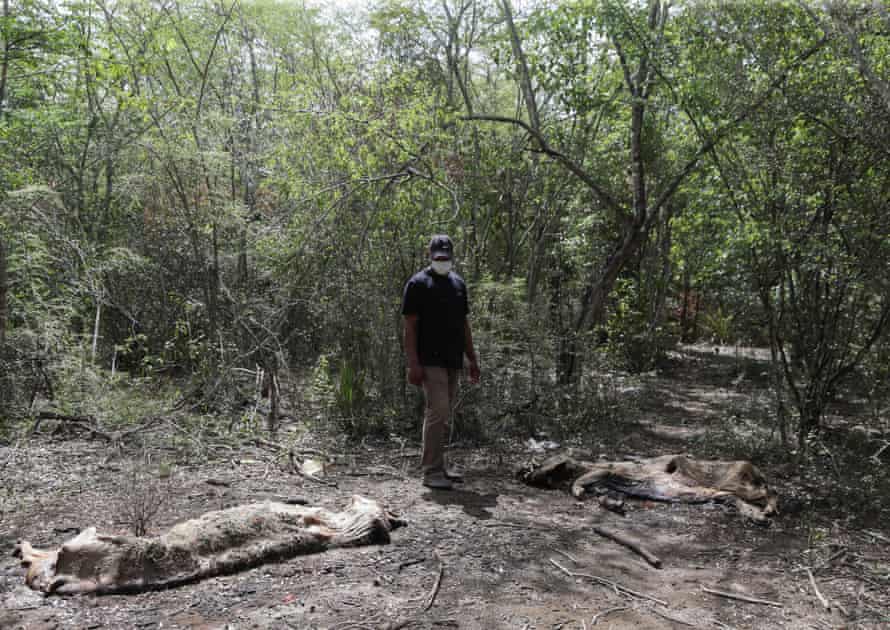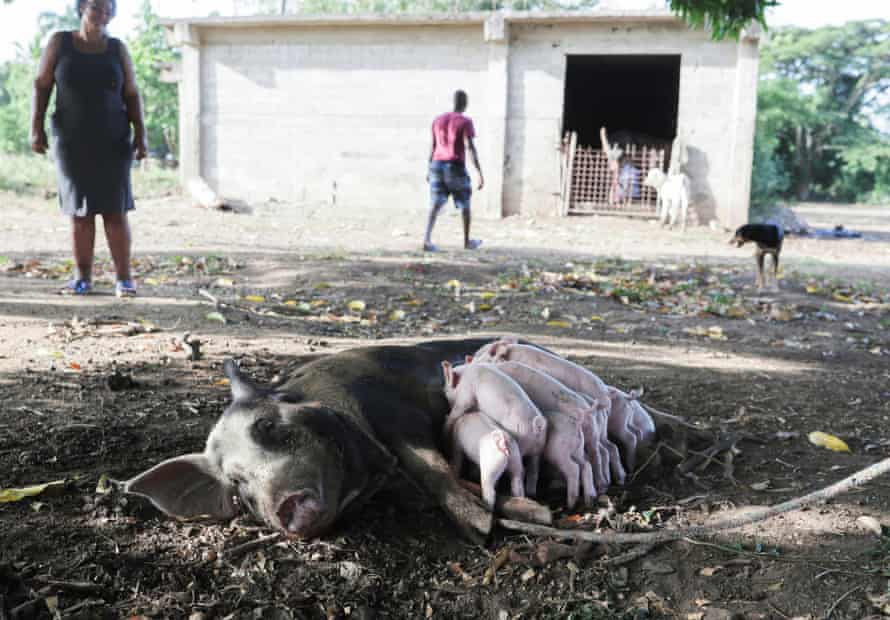The US has a silent pig pandemic on its doorstep once again
As America readies to protect its pork industry, the Dominican Republic has been accused of using an outbreak of African Swine Fever to wipe out smaller producers

Last modified on Sun 17 Oct 2021 05.01 EDT
A pandemic is silently sweeping across the globe – and it is not Covid-19. Since African Swine Fever (ASF) was confirmed in the Americas more than two months ago, the deadly pig disease is now on six continents and on the doorstep of the US.
Samples taken in the Dominican Republic tested positive for ASF in July and in neighbouring Haiti in September.
The virus does not affect humans or meat quality, but is an almost certain death sentence for pigs. The US pork industry – worth $23bn (GBP17bn) a year – is in a panic, Latin America is on alert, and pork producers in the Dominican Republic and Haiti are haunted by memories of the US-funded eradication of their entire pork population when ASF last hit more than 40 years ago.
Rigoberto Echavarria, a Dominican pig farmer, is devastated by the loss of his entire herd in August after staff sent by the Ministry of Agriculture followed an initial government directive to kill all pigs on small farms in affected hotspots and those within a 5km radius of the outbreak. The slaughter happened without prior testing for the virus.
Local reports say at least 1,000 pigs were killed that month in the province of Santiago Rodriguez, where Echavarria lives. But another farmer thinks the killings go beyond 10,000.
Social media accounts show local people throwing stones at a government vehicle loaded with dead pigs protected by armed members of the military.
Some small pork producers banded together to prevent the teams from reaching their farms.
But for Echavarria, it was too late. His farm is in the north-west of the Dominican Republic, 70km from the border with Haiti, where some suspect the disease entered the island. But, like many in his province, he believes his 130 pigs were healthy, and questions whether larger farms are being targeted by the government programme in the same way. He asks: “Can the pigs of my rich friend not also get sick?”
Speaking to the Guardian, an official said 73,000 pigs have been killed out of a pig population estimated at 1.8 million. The size of the farms affected has not been made public, but the numbers suggest the average farm had only 25 pigs.
Dr Rafael Nunez Mieses, director of animal health at the Ministry of Agriculture, attributes the destruction of small farmers’ herds without prior testing for the virus to an initial “lack of equipment”. The strategy later changed.
A government veterinarian in the province of Santiago Rodriguez, who asked to speak anonymously, says: “If the testing equipment had arrived earlier, we would not have had to sacrifice so many pigs.” He adds: “This is an area of small farms.”
But an unpublished technical report obtained by the Guardian reveals that the directive to kill pigs on small farms without prior testing was part of a government plan to control ASF, backed by the International Regional Organization for Agricultural Health and the UN’s Food and Agriculture Organization.
The document says: “Within a radius of 5 to 10 km of each outbreak, following the guidelines outlined in the emergency plan, all back yard farms should be sacrificed (not the industrial ones), independently of whether they are free of infection.”

Dr Francisco Israel Brito, president of the Dominican Federation of Pork Producers, confirms this. “Initially there was a policy to eliminate the small producers in order to contain the illness,” he says. “But then it became clear that, even then, the larger farms couldn’t escape the virus since it was all over the country.
“And the government realised that it was going to be very costly, so they decided to focus on the hotspot areas instead.”
Farmers have been compensated for the killings at a market rate of 120 Dominican pesos/kg (US$ 2.13), but missteps from the Dominican government have not helped to ease farmers’ mistrust.
The international community has been on alert for ASF for years. The Dominican Republic hosted an international conference in Punta Cana in 2018 where ASF was on the agenda. Samples, which had been taken as early as April, were not tested for ASF until July, giving the virus plenty of time to spread.
The Dominican government was quick to point the finger at small farmers on the border in June. But an official report published later by the World Organisation for Animal Health says the country’s first outbreak was in April in the centre of the country, where the majority of industrial-scale pork farms are based.
In a recent report, the international NGO Grain claims the Dominican government is taking advantage of the pig pandemic to eliminate smaller farms, following a similar pattern to that which it reported in China as a result of the ASF variant that has been ravaging states in the former Soviet Union since 2007 and which spread to Asia in 2018.

The Dominican government’s rhetoric has fed the narrative that smaller producers operate illegally and lack the hygiene and nutrition standards to keep the disease at bay.
In Latin America, traspatio – or back yard – pigs are traditionally reared a few at a time for self-consumption, tied to a pole at the back of a modest dwelling where they guzzle food scraps. In 1978, ASF allegedly reached the Dominican Republic via pork leftovers from a flight from Europe fed to a back yard pig outside the airport.
The Dominican government classifies all 28,000 small and medium farms with varying hygiene and nutrition standards as back yard farms. But the small and medium farmers the Guardian spoke to did not feed their pigs on food scraps or let them roam on landfill sites. And they were aware of disease transmission risks.
“Nobody works on this farm except me and one employee. Nobody else visits my farm,” says Echavarria.
Nunez Mieses acknowledges that “not more than 100 farms” in the whole country meet biosecurity protocols “as described in the manual”, adding: “This disease is an opportunity for the pork industry to organise itself.”
Dr Francisco Israel Brito, president of Fedoporc, the Dominican federation of pork producers, confirms that the government was initially “protecting” the 400 or so industrial farms that produce 70% of all Dominican pork.
But he also acknowledges that, much like the coronavirus, ASF does not discriminate, saying: “It affects the most humble and the most powerful alike.”

The US recently announced $500m in funding to support activities related to combating ASF in the Dominican Republic and Haiti, but a US outbreak is not unthinkable. More than 2 million Dominicans live in the US and the Dominican Republic is a popular destination for American tourists. ASF travels well in cured meat in luggage as well as in uncooked pork scraps on boats and aeroplanes.
If the plan to contain the disease by focusing on small farmers fails in the Dominican Republic, then plan B, according to government sources who spoke to the Guardian, is to destroy the whole swine population, as in 1979, when a US-backed eradication took place, followed by one in Haiti in 1982. This would protect the US pork industry and generate a massive increase in the 27% of Dominican pork consumption that mainly comes from the US.
Paul G Rudenberg, a US veterinarian who was part of the USAID effort to introduce pigs from Iowa to Haiti in the mid 1980s, doubts an eradication effort would be politically viable today. He says: “It may have been necessary. But it wasn’t run in the manner that was conducive to the benefit of the small farmer. As a result, it wreaked social economic havoc on Haiti.”
A glimmer of hope lies in the recent development by the US of a potential candidate for a vaccine against ASF; 40 years later, it looks like Big Brother is again likely to call the shots.
As for the small and medium sized farmers in the Dominican Republic, more than anything, what they don’t want is for certain farmers to get preferential treatment due to their size or government contacts.
“As a pig farmer, I am never going to be in favour of eradication. But if they are going to slaughter some of them, they have to slaughter them all,” says Echavarria.
-
Sign up for the Animals farmed monthly update to get a roundup of the biggest farming and food stories across the world and keep up with our investigations. You can send us your stories and thoughts at animalsfarmed@theguardian.com
